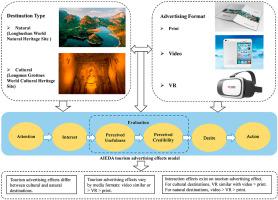Tourism Management ( IF 12.7 ) Pub Date : 2021-02-07 , DOI: 10.1016/j.tourman.2020.104278 Lisheng Weng , Zhuowei Huang , Jigang Bao

|
This study develops the AIEDA tourism advertising effects model and examines this model by tourism destination types and advertising formats in a field experiment. The AIEDA model extends the traditional AIDA model in the advertising field and additionally considers the unique features of tourism products. It includes five hierarchical stages: Attention→ Interest→Evaluation (Perceived Usefulness→ Perceived Credibility) → Desire →Action. Findings of experimental research indicate that destination type and advertising format have main effects and interaction effects on tourism advertising effects. In addition, this study discovered that, for natural and cultural destinations, video ads yielded similar or more positive advertising effects than virtual reality ads, whereas print was the least effective advertising format.
中文翻译:

旅游广告效果模型
这项研究开发了AIEDA旅游广告效果模型,并在野外实验中根据旅游目的地类型和广告格式检查了该模型。AIEDA模型扩展了广告领域的传统AIDA模型,并考虑了旅游产品的独特功能。它包括五个层次阶段:注意→兴趣→评估(感知的有用性→感知的可信度)→欲望→行动。实验研究结果表明,目的地类型和广告形式对旅游广告效果具有主要影响和交互作用。此外,这项研究还发现,对于自然和文化目的地,视频广告产生的效果要比虚拟现实广告更相似或更积极,而印刷则是效果最差的广告形式。


























 京公网安备 11010802027423号
京公网安备 11010802027423号